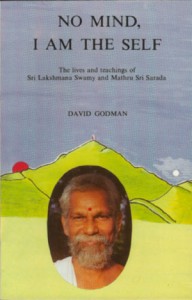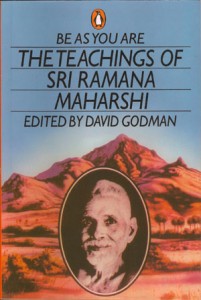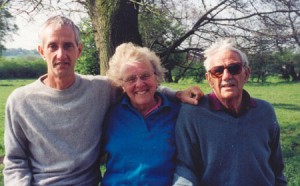About a week later he announced in the morning darshan that he had read the manuscript and liked it. He looked at me and apparently said that I had done a good job. I say ‘apparently’ because I didn’t hear him say this. The other people present all heard him say these words but nothing like this registered in my mind. Lakshmana Swamy is extremely sparing with his praise of devotees, other than Saradamma of course, and I think that this was the only complimentary thing he has ever said about me directly to my face. And I missed it. Maybe he thought it would be bad for my ego to hear it and somehow managed to make sure that everyone there heard it except me.

The manuscript went to a local devotee who had a printing press in Gudur, the local town. Unfortunately, he wasn’t equipped to print books. I think his staple product was wedding invitations and other items of a similar size. He didn’t have enough letters to make a book, and his main compositor seemed to be drunk a lot of the time. For those people who have been brought up on word-processors I need to say that once upon a time books were composed letter by letter. Small metal letters would be hammered into grooves on wooden blocks, the metal surfaces would be inked and a page would be printed as a proof sheet. When mistakes were spotted, the metal letters had to be pulled out and rearranged. It may sound medieval, but this, with many elaborations, was how most of the world’s books were printed up until the 1980s. It can be done fairly quickly by experts, but if you haven’t done a job like this before, it can take months and months. That’s what happened. By the time the visit to Ramanasramam came round, only a few pages had been assembled, and they were full of mistakes. It eventually became clear that this particular press couldn’t do the job, but by then the money for the printing had been spent on other projects. The manuscript was shelved for a few years and was only printed in 1986 when an American devotee came forward and offered to pay for it to be done in a major printing press. Before it was printed in 1986 I took the opportunity to include a few extra stories that had come to light in the intervening years, and I also went through it again to improve the style. The first draft had been done in an extreme hurry, and in several places it showed.
Michelle: Did both Lakshmana Swamy and Saradamma go through the book prior to its publication?
David: Oh yes, they both took their editing work very seriously. Lakshmana Swamy could read and speak English quite well because he had learned the language at school and college. I think he went through the manuscript four or five times, and each time he returned it to me there would be portions deleted or comments added in the margin. When he was finally satisfied with it, a devotee who knew good Telugu and English read it out in Telugu to Saradamma, and she too made a number of changes. It was very much their book, their story. I was just the scribe who put it into shape for them.
Michelle: Let’s move on to Be As You Are. That’s the book that most people associate with you. How did that come to be written?
David: In 1983 I went back to England, hoping to get a job. I had been in India seven years, and for most of the previous five years I had been supported by Ramanasramam because I had been doing various jobs for them – running their library, editing their magazine, and so on. I wanted to come back to India with enough money to be financially independent. I wanted to live outside the ashram, supporting myself, and I wanted to spend more time meditating, without being dependent on an institution for food and accommodation. Well, it didn’t work out. No one wanted to hire me to do anything. I sent off lots of applications for jobs that I was eminently qualified to do and either received no reply at all, or I received rejection letters that were downright offensive. I had started and run a library in India for five years, but when I applied for a job to run a private library that was smaller than the one in Tiruvannamalai, I received a reply that said: ‘Dear Mr Godman, Thank you very much for your very entertaining application. However, we would prefer to engage someone who is qualified to do the job.’ This went on for months. I even blew an interview to pick up litter because I laughed at the wrong moment. Bhagavan says in Maharshi’s Gospel that if you are destined to work, you cannot avoid it, and if you are destined not to work, no matter how hard you look for a job, no one will hire you. That was my situation in the summer of 1983. What I didn’t realise at the time was that Bhagavan had other plans for me. The landlord of the house where I was staying was a philosophy lecturer in Leicester University, and so was his wife. He had just delivered a manuscript his wife had written to the editor of a London publisher.
When she, the editor, discovered that he too was a philosophy lecturer, she had said, ‘Why don’t you write a book for us as well. We are always looking for new books on philosophy.’
I perked up when I heard this. This was something I could do. I called up the editor and asked if she wanted a book on Ramana Maharshi. Her reply astounded me:
‘Come to my office at once. Don’t go anywhere else. We want you. Come right now.’

After months and months of rejections, this was a welcome turn of events. I thought up a quick plan for a book and discussed it with her a few hours later. She checked on the sales figures of the few other books on Ramana that had been published in the West and said, ‘We’ll do it’. It was as simple as that. I was given a contract and sent off to India to put together Be As You Are. I was astonished because I had been brought up believing one of the standard myths of authorship. The would-be writer spends months or years writing a book. He or she then spends just as long sending the manuscript off to various publishers, who all reject it. Then, if he or she is lucky, the 101st publisher finally says ‘Yes’.
It was my destiny to come back to India and write books on Bhagavan, his teachings, and his disciples. When I tried to do something else, I couldn’t make it happen.
When I went to Lakshmana Ashram in 1982, it was to get away from the writing and editing work I was doing for Ramanasramam. Within a couple of weeks I was writing a book there. When I went to England the following year, hoping to generate enough cash so that I wouldn’t have to do writing work in India, I ended up coming back with a contract for a book on Bhagavan. That has been my work, my destiny, more or less ever since. Nowadays, I don’t try to fight it. I enjoy it.
Michelle: Be As You Are was a big success. Most people who have only read one book about Bhagavan’s teachings have probably read that one. Why do you think so many people bought it and appreciated it? There are many other books around on Bhagavan’s teachings.
David: The book did very well outside India because it had a structure that made the teachings accessible and understandable. Bhagavan’s teachings can be very confusing if you don’t have a background of Vedanta, or if you don’t understand that he gives different answers to the same question to different people. I think the book succeeded because readers were given the right set of keys to understand all the different things he said, all the different levels of the teachings.
When I went to see the editor in London for that first meeting, she asked if I had a sample to show her. I didn’t because I had only dreamed up the scheme that morning.
I told her, ‘I’ll lend you my copy of Talks with Sri Ramana Maharshi. It’s the biggest collection of his dialogues. I will definitely be taking quite a few extracts from this book.’
When I collected the book a couple of days later she had a bemused look on her face.
‘I hope your book is better than this,’ she said. ‘I couldn’t understand a word of it.’
This was a woman who was the commissioning editor of the spiritual book division of a major London publisher. If people like her can’t understand Bhagavan’s teachings by reading books such as Talks, it’s a good guess that most other people can’t make much sense of them either.
The other thing that made it such a success was Penguin’s ability to distribute it so well. Throughout the 80s and 90s I was astounded at all the different places I saw it on sale. If a bookstore only had ten spiritual books on its shelves, Be As You Are would usually be one of them. For many people in the West Be As You Are was their introduction to Bhagavan simply because it was the only book on Bhagavan’s teachings that ever made it to the shelves of their local bookstore.

I remember going with my father and his second wife into a boutique in Pondicherry around 1990. They were hunting for cheap clothes and souvenirs. Near the checkout counter there was a magazine rack and a shelf that had four books for sale. One was a Delia Smith best-selling cookery book. The next two were airport-style thriller novels by famous authors of that genre, and the fourth was Be As You Are. My father was very impressed to find me in such company. Judging by the comments he made to other people, he wasn’t particularly impressed by the life I had chosen for myself.
Michelle: How long did it take you to compile this book?
David: I suppose I did it in two or three months, mostly in my spare time. When I went back to India, I took over the running of the Ramanasramam library again, and that was a seven-day-a-week job. I did the editing in the evenings. However, saying this is a bit misleading because I had spent the previous seven years reading and studying the Ramana literature, and I had spent years doing self-enquiry quite intensively. In addition to all this, I had had many long discussions and debates with other devotees on all aspects of the teachings. All this matured into the understanding that I presented in the book. If a musician tells you that he just spent a week learning a new piece of music, it is understood that he spent several years prior to that week mastering his instrument. I put the book together in a few weeks, but I can also say that it was the culmination of several years of study and practice.
Michelle: You said that you typed out No Mind – I am the Self on a broken typewriter. Had your technology improved by the time you did Be As You Are?
David: Not really. I didn’t even own a typewriter. I had to borrow one to type out the final draft. Before I started the work I bought copies of all the Ramana books I thought I would need from the ashram bookstore. Then I cut out all the teaching dialogues and put them in files. I arranged the clippings into subjects and then stapled conversations to pieces of blank paper in an order that seemed to make sense to me. It was classic cut-and-paste word-processing, but I did it with scissors and a stapler instead of a computer. I don’t think I even saw a computer until about five years later. When I was satisfied with the order of the extracts, I wrote brief introductions to each chapter and then typed the whole thing out. I had been given an 80,000-word limit by the publisher. I wanted to go right up to that limit and have as much of Bhagavan as possible in the book. That meant keeping my explanations brief and terse. It’s occasionally good to have limits like this. It makes you think about the essence of the teachings. Also, summarising complex ideas in half a page is a good test of one’s understanding.